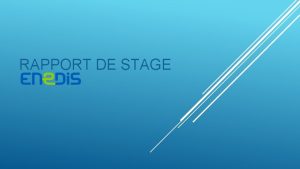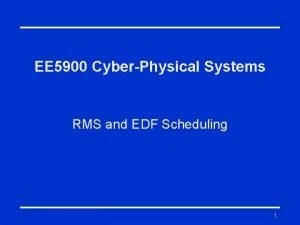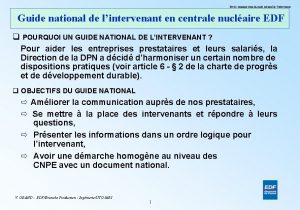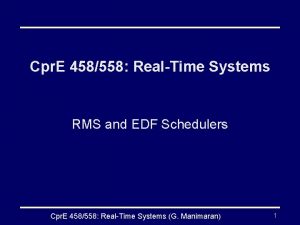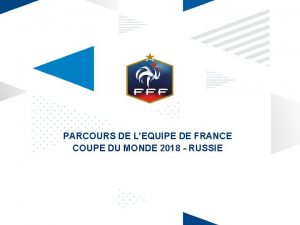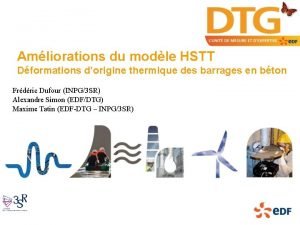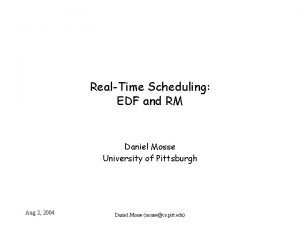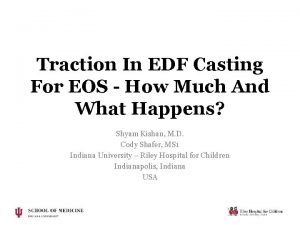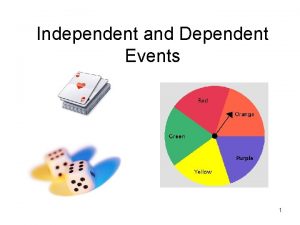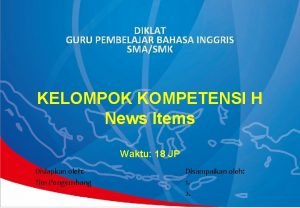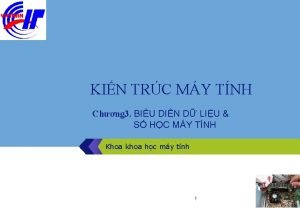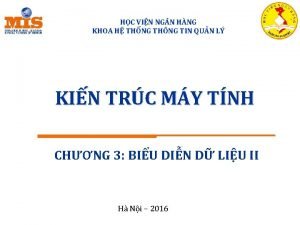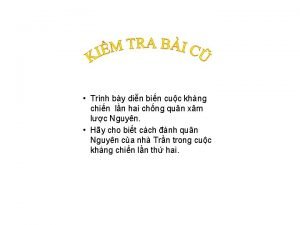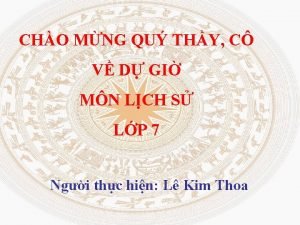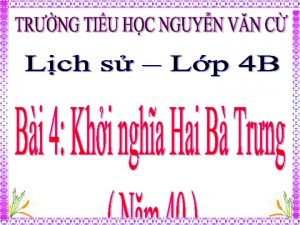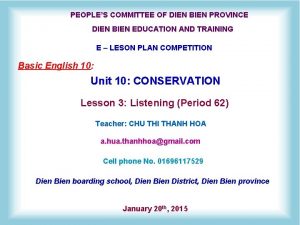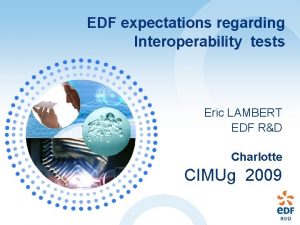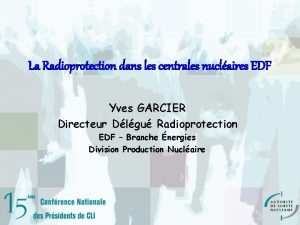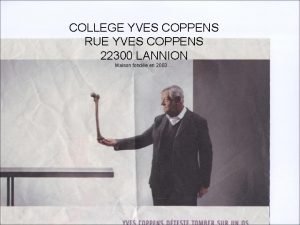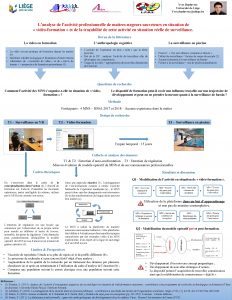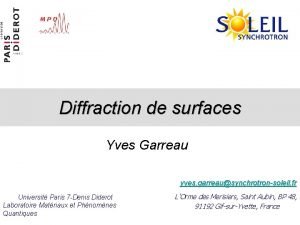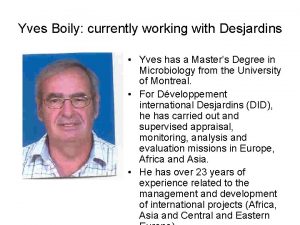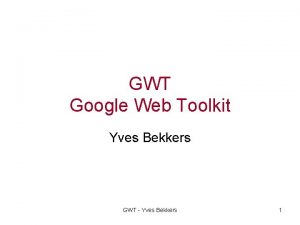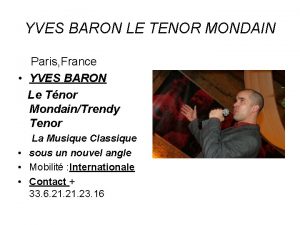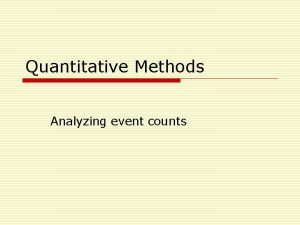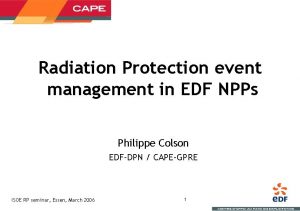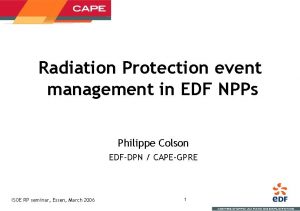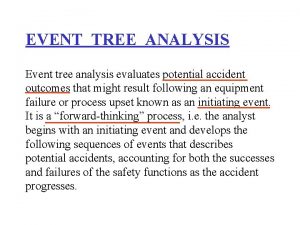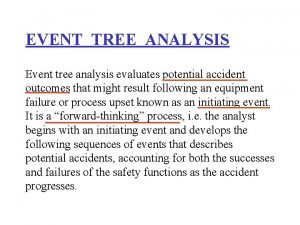EVENT ANALYSIS METHODS YVES DIEN EDF RD yves
































- Slides: 32

EVENT ANALYSIS METHODS YVES DIEN EDF R&D, yves. dien@edf. fr CHAOS, yves. dien@hotmail. fr NICOLAS DECHY IRSN, nicolas. dechy@irsn. fr

ASSUMPTION 1 • Appropriate investigation/analysis is of upmost importance in term of safety (improvement) • We can learn from our own failures / errors • Need to figure out • • What actually went wrong Why it went wrong JRC ISPRA BENCHMARKING EXERCISE November 5 -6, 2015 2

ASSUMPTION 1 (C'td) • “Many accident investigations do not go far enough. They identify the technical cause of the accident, and then connect it to a variant of “operator error” […]. But this is seldom the entire issue When the determinations of the causal chain are limited […], typically the actions taken to prevent a similar event in the future also limited […]. Putting these corrections in place leads to another mistake – the belief that the problem is solved. ” solved • CAIB report p. 97, 2003 (emphasis added) JRC ISPRA BENCHMARKING EXERCISE November 5 -6, 2015 3

ASSUMPTION 2 • Investigation method used will depend on vision about event occurrence • • • An exceptional set of unfortunate circumstances in an isolated case "Act of God" (Unforeseeable) residual risk "Normal accident" (in the sense of Charles Perrow) Consequence of failures (to investigate, analyse and remedy) JRC ISPRA BENCHMARKING EXERCISE November 5 -6, 2015 4

ASSUMPTION 2 (C'td) Operator(s) action(s)/“error(s)” EVENT NB: Either S 1, S 2, S 3 or S 4 leads to the event Technical failure ROFi P/ROF = Pathogenic Resilient Organisational Factors POFn = (Small) events [(weak) signals] not detected as symptoms of deterioration of the situation EVENT (“organisational accident”) Pre Event Situation Post Event Situation Time for prevention Crisis Management JRC ISPRA BENCHMARKING EXERCISE November 5 -6, 2015 5

FEW (SELECTED) ANALYSIS METHODS THE "MOST WELL KNOWN" JRC ISPRA BENCHMARKING EXERCISE November 5 -6, 2015 6

CAUSAL TREE ANALYSIS • Causal tree (France, INRS, 70’s) • Method principles (1/2) • To develop an objective understanding of the process which led to the accident (versus to determine accountability/responsibility) • • To highlight facts and no interpretations nor value judgments To take account of facts as upstream as possible about “accident genesis” with a deductive approach JRC ISPRA BENCHMARKING EXERCISE November 5 -6, 2015 7

CAUSE TREE ANALYSIS (C'td) • Method principles (c'td) • To respect steps sequence, especially step “data collection and causal tree construction” and step “actions proposals” • To use an observation framework which is related to the work situation in a simplified manner • • Individual: Individual operator(s), employee(s), worker(s), victim(s), … Task/Activity (actual work): actions which have contributed to accident Equipment(s) Equipment used: tools, material(s), product(s), … Accident surrounding: surrounding work spaces, physical and psychological environments, … JRC ISPRA BENCHMARKING EXERCISE November 5 -6, 2015 8

CAUSAL TREE ANALYSIS (C'td) • Data Collection • 2 types of information sources • • From Work environment From Interviews Code of ethical conduct for interview Data to be collected: FACTS • • Fact = information, state, value, . . Fact ≠ interpretation, opinion, value judgments, “negative facts”, … • • • e. g. He/she worked while he/she wore sport shoes is a fact He/she did not wear his/her protective footwear is NOT a fact Starting point of analysis is the event (how to define event) JRC ISPRA BENCHMARKING EXERCISE November 5 -6, 2015 9

CAUSAL TREE ANALYSIS (C'td) • Example of a "causal tree" • A farm worker has to hitch a trailer Ti to a tractor Tc 1, the usual tractor is out of order. Worker decides to use tractor Tc 2 that he does not usually drive. Yet, Tc 2, contrary to Tc 1, has a height difference with the trailer connecting device. So, coupling becomes uneasy. Therefore, worker places himself between Tc 2 and Ti in order to lift Ti and to achieve hanging. But Tc 2 parking brake has not been applied and because its engine was still running, it is subject to jarring. Moreover, ground is sloping. It leads that Tc 2 moves back (unexpectedly) and that the worker, “stuck” between Ti and Tc 2, is injured. JRC ISPRA BENCHMARKING EXERCISE November 5 -6, 2015 10

CAUSAL TREE ANALYSIS (C'td) • Example of a "causal tree" Tc 1 out of order Tc 2 unusual Height difference between Tc 2 and Ti Difficult coupling Brake off Worker “stuck” between Tc 2 & Ti Tc 2 Engine on Sloping ground Worker between Tc 2 & Ti Tc 2 “shakes” Injury Tc 2 moves back November 5 -6, 2015 11

BARRIER ANALYSIS Barriers • Goal • • Focus on • • • To identify hazards linked to an event and barriers (and controls as well) which led to it Performance of barriers in place Barriers not used Missing barriers Barriers which need evolved Types of barriers • • Physical: Physical Equipment and engineering design, Safety devices, Protective clothing, Warning devices… Management: Management Hazard analysis, Knowledge/skills, Line management oversight, Training, Work planning, and procedures… JRC ISPRA BENCHMARKING EXERCISE November 5 -6, 2015 12

BARRIER ANALYSIS (C'td) • A several steps analysis • • • Step 1: Identify the hazard and the target. Step 2: Identify each barrier. Step 3: Identify how the barrier performed Step 4: Identify and consider probable causes of the barrier failure Step 5: Evaluate the consequences of the failure in this accident JRC ISPRA BENCHMARKING EXERCISE November 5 -6, 2015 13

BARRIER ANALYSIS (C'td) • Barrier Analysis sheet Hazard (required) Barriers Identification JRC ISPRA BENCHMARKING EXERCISE Performance of Barriers Target Cause of Failure (if any) Effect on the event occurrence November 5 -6, 2015 14

CHANGE ANALYSIS • Goal • To figure out every change (planned and unplanned that led to the event occurrence • Change analysis can be seen as a "first step" of another method • Not a "self-supporting" method • Change analysis is a process • Impact of changes on event occurrence JRC ISPRA BENCHMARKING EXERCISE November 5 -6, 2015 15

CHANGE ANALYSIS (C'td) • Change Analysis Process Description of accident situation Comparaison Identification of differences Impact on Accident Analyse differences Description of comparable accident-free situation Results as input into events chart JRC ISPRA BENCHMARKING EXERCISE November 5 -6, 2015 16

MTO • • (Hu)Man, Technology and Organisation Analysis The MTO-analysis is based on three methods: • • Change analysis Barrier analysis (technological and administrative barriers) Identification of failure causes based on a checklist (10 items) • • Structured analysis by use of an event tree. Organisation, Work organisation Work practice, Management work, Change procedures, Ergonomic / deficiencies in the technology, Communication, Instructions/procedures, Education/competence, Work environment Each failure cause is analysed according to its basic(root) causes • A specific checklist for every "failure cause" JRC ISPRA BENCHMARKING EXERCISE November 5 -6, 2015 17

MTO (C'td) • Last step: definition of corrective measures • Realistic and specific measures JRC ISPRA BENCHMARKING EXERCISE November 5 -6, 2015 18

ACCI-MAP • Jens Rasmussen and Inge Svedung work • More a "risk management method" rather than an "event analysis method" • Nevertheless outputs of the method useful for event analysts • Stress on importance of decision making at every level and interaction between levels • Stress on importance of past events analysis JRC ISPRA BENCHMARKING EXERCISE November 5 -6, 2015 19

ACCI-MAP (C'td) JRC ISPRA BENCHMARKING EXERCISE 20

MORT • MORT is a systematic method for planning, organising, and conducting a comprehensive accident investigation • MORT is a graphical checklist with generic questions that investigators attempt to answer using available factual data • Use of a colour coding for events • An extensive training (few days) is needed for performing an in-depth analysis of complex accidents JRC ISPRA BENCHMARKING EXERCISE November 5 -6, 2015 21

BARRIERS Losse s Hazards Causes TRIPOD Latent Conditions Investigation Unsafe acts Local workplace factors • • • James Reason work • • • BRFs are latent failures Organisational factors Organisational failures are the main factors in accident occurrence Event is generated by mechanisms resulting from decisions mechanisms result from decisions: the Basic Risks Factors (BRF) "Generic" factors have"specific" impacts (at "lower levels) 11 BRFs • Design, Tools and Equipment, Maintenance Management, Housekeeping, Error Enforcing Conditions, Procedures, Training, Communication, Incompatible goals, Organisation, Defences • TRIPOD Beta: computer tool making a representation of the event JRC ISPRA BENCHMARKING EXERCISE November 5 -6, 2015 22

TRIPOD (C'td) Decision makers BRFs but Defence Psycho. Pécursors Barriers breached Substandard acts Operational Disturbance Accident Consequences Defences TRIPOD model JRC ISPRA BENCHMARKING EXERCISE November 5 -6, 2015 23

The FRAM • Erik Hollnagel work • The Functional Resonance Analysis Method • Functional variability • Basic principles 1. 2. 3. 4. Principle of Equivalence of Successes and Failures Principle of Approximate Adjustments Principle of Emergence Principle of Functional Resonance JRC ISPRA BENCHMARKING EXERCISE November 5 -6, 2015 24

The FRAM (C'td) • Steps of Analysis • • • Description of the event Description of what should happen The description is basically the set of functions that are required for everyday performance to succeed (data from daily work rather than data from event investigation) Characterising the variability (previous step is the FRAM model) Use of more specific information (e. g. , an event analysis) to propose more instantiations of the model Analyse of instantiations to find an explanation why something happened The FRAM Model Visualiser (FMV): a software tool for building a model and automatically creating a graphical representation of a FRAM model JRC ISPRA BENCHMARKING EXERCISE November 5 -6, 2015 25

STAMP • • Nancy Leveson work STAMP: System-Theoretic Accident Model and Processes Based on systems theory, not reliability theory Accidents causes: dynamic control problems (vs. a failure problem) • Example of control problem: O-ring did not control propellant gas release by sealing gap in field joint of Challenger Space Shuttle • Taking into account • The whole socio-technical system • Interaction between elements • Errors (e. g. design errors, human errors) JRC ISPRA BENCHMARKING EXERCISE November 5 -6, 2015 26

STAMP (C'td) • Assumption • Accidents occur when interactions between system components violate constraints related to their behavior • Goal is to control the behaviour of the components and systems to ensure safety constraints are enforced • Example of safety constraint: Power must never be on when access door open JRC ISPRA BENCHMARKING EXERCISE November 5 -6, 2015 27

STAMP (C'td) • Occurrence of accidents is complex • How to cope with complexity 1. Analytic Reduction: system division into distinct parts (physical components separation and distinction of event over time for behaviours • 2. Separation possible and no distortion of phenomena (each component has to operate independently) Statistics system seen as a structureless mass with interchangeable parts • Treatment of components behaviour (supposed regular and random enough) in terms of averages JRC ISPRA BENCHMARKING EXERCISE November 5 -6, 2015 28

ORGANISATIONAL ANALYSIS • Assumption • Any event is generated by direct or immediate causes (technical failure and/or “human error”), NEVERTHELESS, its occurrence and/or its developing is considered to be induced, facilitated or accelerated by underlying organisational conditions (complex factors) • Definition (attempt) • OA intends to explain, to put in obvious place some processes and phenomena within organisation in following a specific goal: analysis of an event, with a perspective of improvement of safety JRC ISPRA BENCHMARKING EXERCISE November 5 -6, 2015 29

ORGANISATIONAL ANALYSIS (C'td) • OA Dimensions 1. 2. 3. Historical dimension: dimension going back in time (“upstream”) for comprehending and analysing processes and trends that led to the event/situation and, meticulous examination of past events Transversal dimension (organisational network): network) Connections and interaction between “entities” involved (beyond a single company). Organisational network is not an organisational chart Vertical dimension (part of organisational network): network) Interactions between "hierarchical levels" (relations between “field operators”, experts and management) – Focus on Mode of co-operation, Mode of communication, Information flows, Different (? ) visions of the world… JRC ISPRA BENCHMARKING EXERCISE November 5 -6, 2015 30

ORGANISATIONALOrganisational ANALYSIS (C'td) Vertical dimension • Space of analysis ANALYSIS “WITHIN” ORGANISATION THICKNESS Organisational Transversal dimension INCUBATION PERIOD JRC ISPRA BENCHMARKING EXERCISE Historical dimension November 5 -6, 2015 31

THANK YOU FOR YOUR ATTENTION JRC ISPRA BENCHMARKING EXERCISE November 5 -6, 2015 32
 5 ws of event management
5 ws of event management Guy buckenham edf
Guy buckenham edf Pgi gta edf
Pgi gta edf Epr olkiluoto
Epr olkiluoto Mehta casting procedure
Mehta casting procedure Rms and edf scheduling example
Rms and edf scheduling example Edf energy
Edf energy Guide national de l'intervenant en centrale nucléaire edf
Guide national de l'intervenant en centrale nucléaire edf Edf
Edf Simulateur domofinance
Simulateur domofinance Cms.edf.school
Cms.edf.school Rms edf
Rms edf Rms and edf scheduling example
Rms and edf scheduling example Parcours edf cdm 2018
Parcours edf cdm 2018 Edf change of tenancy
Edf change of tenancy Dtg edf
Dtg edf Rm
Rm Shyam kishan md
Shyam kishan md Uto edf
Uto edf Sentinel event بالعربي
Sentinel event بالعربي Simple and compound events examples
Simple and compound events examples Independent event vs dependent event
Independent event vs dependent event Independent and dependent probability
Independent and dependent probability Peta konsep news item
Peta konsep news item To inform the readers/listeners about a newsworthy event
To inform the readers/listeners about a newsworthy event Fabrication of wax pattern
Fabrication of wax pattern Thần linh của chúa hiện diện nơi đây
Thần linh của chúa hiện diện nơi đây đặc điểm văn biểu cảm
đặc điểm văn biểu cảm Dấu chấm tĩnh
Dấu chấm tĩnh Biểu diễn số thực theo chuẩn ieee 754
Biểu diễn số thực theo chuẩn ieee 754 Trình bày diễn biến
Trình bày diễn biến Chùa diên hựu
Chùa diên hựu đinh thị vân
đinh thị vân


